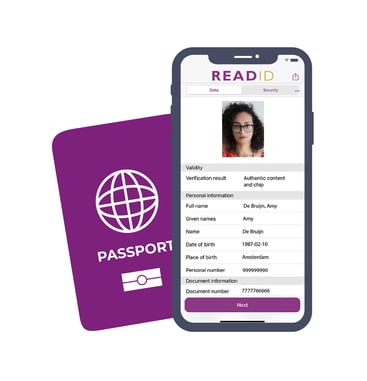Vietnam is strengthening its digital banking infrastructure by making biometric verification not only compulsory for high-value online transactions by individuals, but now also extending the requirement to corporate customers. This evolution forms part of a broader strategy to enhance security in the financial sector and combat identity fraud. It is essentially aimed at cleaning up bank accounts and eliminating accounts that are not under the rightful owner’s name. “We can rest assured that there will be no bank accounts opened using fake documents,” said Deputy Governor Phạm Tiến Dũng. NFC‑based identity verification is a powerful tool to achieve it.
Legal Background
Vietnam’s push for stronger identity verification in digital banking is anchored in Decision No. 2345/QD-NHNN on the application of safety and security measures to online and card-based payments, issued by the State Bank of Vietnam. The regulation, that took effect on July 1, 2024, initially required biometric authentication for individual customers conducting high‑risk transactions:
- Money transfers exceeding VND 10 million (EUR 326) or daily cumulative money transfers over VND 20 million (EUR 652 approx.)
- Payment transactions (e.g., online shopping) over VND 100 million (EUR 3.267) per transaction or over VND 100 million per day
- International interbank money transfers regardless of transaction value
In addition, biometric authentication is also required for first-time mobile banking payments and transactions from a new or unrecognized device. Under Circulars 17/2024/TT‑NHNN and 18/2024/TT‑NHNN, the scope now covers corporate customers: legal representatives of corporate accounts were required to register their biometric data by July 1, 2025, to maintain access to digital banking services.
For individual customers, the deadline to complete biometric registration was set earlier—January 1, 2025. Customers who fail to meet this requirement will be restricted to in-person, counter-based transactions only. They will no longer be able to perform online activities such as money transfers, withdrawals, bill payments, deposits, or ATM/CDM operations. Furthermore, individuals with expired identification documents will have their access to all payment channels suspended.
What Does This Mean in Practice?
Banks in Vietnam must make sure that only the account owner is using the online banking services. First step- the biometric data needs to be collected. Biometric data registration can be done in several ways:
- Using an NFC chip-based identity card, where the facial image is stored in the embedded chip. Importantly, under Law No. 26/2023/QH15 (Citizen Identification Law), old paper-based 9-digit identity cards expired after December 31, 2024. Now, only the new 12-digit identity cards are allowed in circulation. Though there are still some non-chipped 12-digit identity cards in circulation, Vietnamese citizens are encouraged to upgrade to NFC chip-based identity cards, as many agencies, including banks, prefer or even require chip-based cards.
- Through the VNeID app’s digital ID; a Level 2 account—the highest security tier providing full digital authentication—is required.
- In person at a bank branch, where biometric data is collected.
Once biometric data has been collected, authentication can be performed each time the customer initiates a high-risk transaction. For transactions classified as very high risk, i.e., type D transactions (see Annex 01 for more information on transaction classification), biometric authentication must be combined with an additional verification method.
A Challenge for Banks
While these changes enhance customer security, banks face challenges with implementation. At a conference hosted by the Vietnam Banks Association a year ago, Mr. Trần Công Huỳnh Lan, Chair of the Banking Association's Technology Committee, pointed out the low success rates in reading chip-based ID cards via NFC, among other obstacles.
Banks are now tasked with balancing regulatory compliance and a seamless user experience. NFC-based identity verification (IDV) is a practical solution—especially since, as of January 1, 2025, all Vietnamese citizens are required to hold chip-enabled identity documents. With NFC, banks can verify the authenticity of the identity document used for biometric registration and extract the high-resolution facial image embedded in the chip. This image can then be matched against a selfie to confirm that the person registering the biometric data is both the rightful document holder and physically present. The high-quality facial image obtained from the chip also serves as a reliable reference for future biometric authentication.
However, many banks mistakenly treat NFC-based IDV as a simple commodity service. This is a misstep. Not all NFC-based IDV solutions deliver the same performance. Some of our customers have reported conversion rates below 30% when using other vendor solutions. It doesn’t have to be this way—with the right technology partner, NFC-based IDV can be both secure and user-friendly.
Why Choose ReadID?
At Inverid, we understand the demands of secure digital onboarding. Our solution, ReadID, provides a proven, compliant, and user-friendly approach to NFC-based identity verification.
- Fraudless Conversion
Over more than 10 years, no fraudulent identity document has been accepted—to the best of our knowledge—thanks to ReadID’s rigorous document authenticity checks. Besides, ReadID creates optimal conversion through excellent user experience.
- Easy to Use
ReadID supports over 2,700 smartphone models and is compatible with documents from about 175 countries. Dynamic animations guide users through the process, enabling real-time verification in under one minute.
- Secure by Design
We treat biometric and identity data with the highest level of care. Our infrastructure meets top-tier security certifications, supported by secure hosting and best-of-breed technology partners.
- Fast Deployment
Use ReadID Ready, our customizable ready-for-use app, or integrate our SDK directly into your existing mobile app using well-documented APIs. Get up and running within days, not months.


.png)







